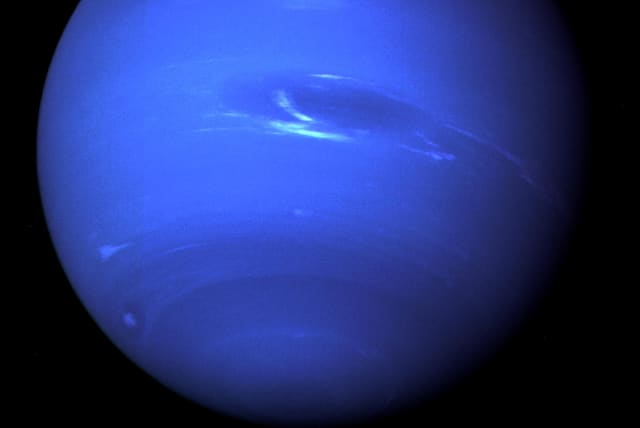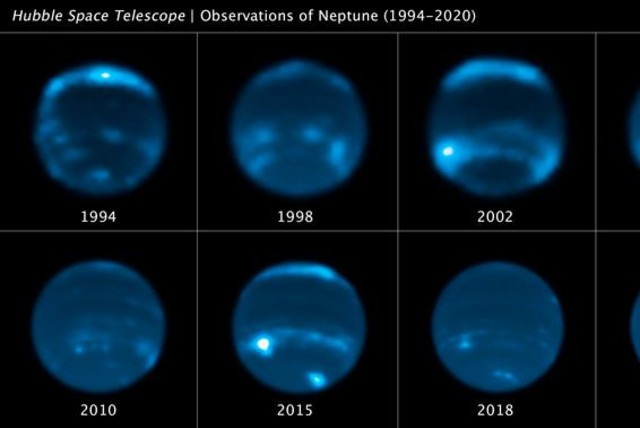What happened to Neptune’s missing clouds? – study

Despite receiving only 0.01% of the light the Earth does, the Sun's UV rays may be controlling Neptune's weather.
Astronomers have discovered a new clue as to where Neptune’s shifting clouds have gone and why, according to a new study published on June 9.
The peer-reviewed study, which is published in the academic journal Science Direct, found that the Sun’s magnetic fields may have a role to play in the mysterious cloud disappearances.
The discovery was enabled through images captured by NASA’s Hubble Space Telescope, the W. M. Keck Observatory in Hawaii, and the Lick Observatory in California. Images were analyzed by the researchers from 2002 onwards.
The Sun and Neptune
Scientists hadn’t considered that the Sun’s magnetic field would be behind the missing clouds as Neptune is located the furthest from the Sun and receives only 0.1% of the sunlight the Earth receives. However, despite the distance, the Sun is indeed the culprit.
Neptune’s cloudy weather is driven by solar activity, not the planet’s seasons which each last 40 years. The Sun’s magnetic fields change every 11 years, as does Neptune’s cloud cover.
When the weather on the Sun is particularly stormy, more intense ultraviolet (UV) radiation is expressed to the solar system. Over the last 2 years, which has been the solar cycle’s peak, the number of clouds on Neptune has significantly increased. The team further found a positive correlation between the number of clouds and Neptune’s brightness from the sunlight reflecting off it.
"These remarkable data give us the strongest evidence yet that Neptune's cloud cover correlates with the Sun’s cycle," said Imke de Pater, emeritus professor of astronomy at UC Berkeley and senior author of the study. "Our findings support the theory that the Sun's UV rays, when strong enough, may be triggering a photochemical reaction that produces Neptune’s clouds."
Currently, Neptune’s clouds can be seen floating closer to the surface of the planet and particularly accumulated in the south pole.
"I was surprised by how quickly clouds disappeared on Neptune," said de Pater. "We essentially saw cloud activity drop within a few months," she said.
"Even now, four years later, the most recent images we took this past June still show the clouds haven't returned to their former levels," said Erandi Chavez, a graduate student at the Center for Astrophysics | Harvard-Smithsonian (CfA) in Cambridge, Massachusetts, who led the study when she was an undergraduate astronomy student at UC Berkeley. "This is extremely exciting and unexpected, especially since Neptune's previous period of low cloud activity was not nearly as dramatic and prolonged."
"It's fascinating to be able to use telescopes on Earth to study the climate of a world more than 2.5 billion miles away from us," said Carlos Alvarez, staff astronomer at Keck Observatory and co-author of the study. "Advances in technology and observations have enabled us to constrain Neptune's atmospheric models, which are key to understanding the correlation between the ice giant's climate and the solar cycle."
We have seen more clouds in the most recent Keck images that were taken during the same time NASA's James Webb Space Telescope observed the planet; these clouds were in particular seen at northern latitudes and at high altitudes, as expected from the observed increase in the solar UV flux over the past approximately 2 years," said de Pater.
Jerusalem Post Store
`; document.getElementById("linkPremium").innerHTML = cont; var divWithLink = document.getElementById("premium-link"); if (divWithLink !== null && divWithLink !== 'undefined') { divWithLink.style.border = "solid 1px #cb0f3e"; divWithLink.style.textAlign = "center"; divWithLink.style.marginBottom = "15px"; divWithLink.style.marginTop = "15px"; divWithLink.style.width = "100%"; divWithLink.style.backgroundColor = "#122952"; divWithLink.style.color = "#ffffff"; divWithLink.style.lineHeight = "1.5"; } } (function (v, i) { });

